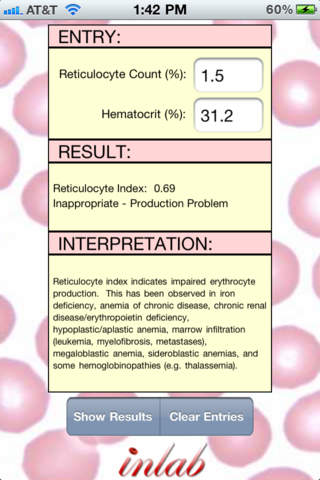
Reticulocyte Index
Reticulocytes are juvenile red blood cells that still contain developmental remnants (RNA). These not fully mature cells are normally present in low numbers in blood (~1%). In a Wright stained blood smear, they are large (macrocytic), have reduced central pallor, and have a more purple hue (polychromasia). By new methylene blue stain, the RNA can be visualized, and the cells can be counted and possibly characterized as early or late forms. In less than 24 hours of release from the bone marrow, these cells mature primarily by circulating through the spleen and losing their RNA remnants.
Testing for reticulocytes is important in the evaluation of patients with anemia. The reticulocyte count is the percentage of reticulocytes in the blood. This is typically obtained by automated instrumentation. In anemic patients, this count must be "corrected" to account for the decreased hematocrit. The result of this mathematical correction is the reticulocyte index. The reticulocyte index tells the clinician whether the patients bone marrow is responding appropriately to anemia by producing and sending out more reticulocytes than normal, or whether the bone marrow is failing to respond to the anemia by not increasing reticulocyte production and release. In some anemia cases, the reticulocyte index does not clearly delineate a hyperproductive reticulocyte state from an underfunctioning bone marrow. Nevertheless, it is a powerful tool in the evaluation of patients with anemia.



